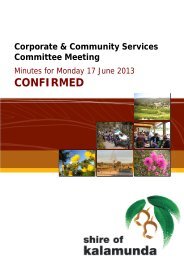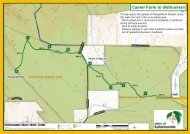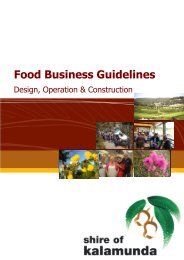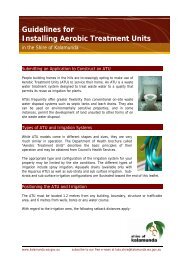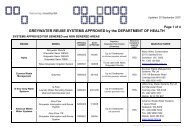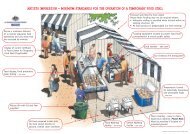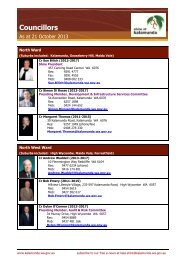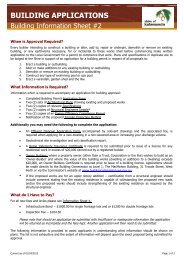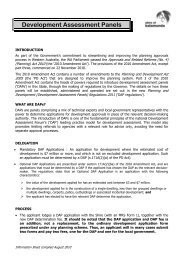Local Biodiversity Strategy: - Shire of Kalamunda
Local Biodiversity Strategy: - Shire of Kalamunda
Local Biodiversity Strategy: - Shire of Kalamunda
Create successful ePaper yourself
Turn your PDF publications into a flip-book with our unique Google optimized e-Paper software.
11.9.5 Carbon Trading<br />
There are other programs which may, in the future, help to reduce the threats to<br />
biodiversity. Emissions trading using carbon credits as the basis for trading is aimed<br />
at reducing the level <strong>of</strong> emissions from human activities to slow or reduce the rate <strong>of</strong><br />
climate change.<br />
Emissions trading in Australia is currently in transition between a voluntary scheme<br />
which has run for a number <strong>of</strong> years and mandatory, regulated trading in 2010.<br />
One voluntary program is Landcare Australia’s CarbonSMART program. Through this<br />
program farmers and landholders can earn money by planting and maintaining<br />
vegetation for biodiversity. Individuals and businesses can then buy carbon credits<br />
from these landholders. This program is currently run in NSW however Landcare are<br />
looking to expand nationally once a national carbon trading system is initiated.<br />
Planting cleared land with species local to the area will benefit natural areas by<br />
reducing the threats from weeds and helping to buffer existing natural areas.<br />
One current constraint on using biodiversity based revegetation for carbon credit<br />
generation is the lack <strong>of</strong> knowledge about the carbon uptake <strong>of</strong> local endemic<br />
species. Greening Australia and Carbon Neutral are initiating research in the South<br />
West <strong>of</strong> WA, which may have benefits in helping identify carbon uptake rates<br />
relevant to the <strong>Shire</strong> <strong>of</strong> <strong>Kalamunda</strong>.<br />
11.10 Environmental Levy<br />
Section 6.38 <strong>of</strong> the <strong>Local</strong> Government Act 1995 allows Councils to impose a service<br />
charge on a landowner or occupier to meet the cost <strong>of</strong> providing a prescribed service<br />
for the land. An opportunity exists for Council to consider introducing such a levy to<br />
raise funds for environmental programs such as biodiversity conservation, acquisition<br />
<strong>of</strong> assets and general management and improvement expenditures.<br />
An example <strong>of</strong> a successful levy is the Bushland Preservation Levy introduced by the<br />
City <strong>of</strong> Brisbane. The levy is $30 a year from each rateable property. The Council has<br />
used funds from this levy to purchase and restore over 1600ha <strong>of</strong> natural bushland.<br />
Other Councils have used different approaches to calculate the amount and focus <strong>of</strong><br />
such levies. The common factors where levies have been used successfully are:<br />
• Community consultation to determine whether such a mechanism would have<br />
community support;<br />
• Community involvement in developing the priorities, scope and amount for<br />
any levy;<br />
• Clear and visible public reporting on funds raised, expenditure and outcomes<br />
achieved;<br />
• Feasibility study identifying the mechanism suitable for the purpose and the<br />
Council’s rates base; and<br />
• Regular review.<br />
The introduction <strong>of</strong> an environmental levy to fund biodiversity conservation initiatives<br />
should be investigated by the <strong>Shire</strong>. Community consultation will be required in order<br />
<strong>Local</strong> <strong>Biodiversity</strong> <strong>Strategy</strong> Page 87



